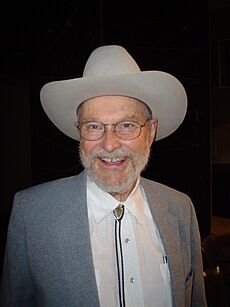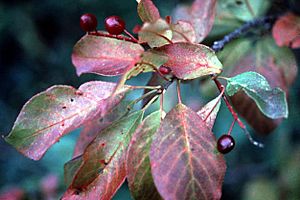Lewistown, Montana facts for kids
Quick facts for kids
Lewistown
|
|
|---|---|

Main Street in Lewistown
|
|
| Motto(s):
"Home of Big Springs and the purest drinking water in the world!"
|
|

Location of Lewistown, Montana
|
|
| Country | United States |
| State | Montana |
| County | Fergus |
| Area | |
| • Total | 5.72 sq mi (14.82 km2) |
| • Land | 5.72 sq mi (14.82 km2) |
| • Water | 0.00 sq mi (0.00 km2) |
| Elevation | 4,121 ft (1,256 m) |
| Population
(2020)
|
|
| • Total | 5,952 |
| • Density | 1,040.20/sq mi (401.60/km2) |
| Time zone | UTC−7 (Mountain (MST)) |
| • Summer (DST) | UTC−6 (MDT) |
| ZIP code |
59457
|
| Area code(s) | 406 |
| FIPS code | 30-43375 |
| GNIS feature ID | 2410827 |
| Website | http://www.cityoflewistown.com |
Lewistown is a city in Montana, United States. It is the main city and county seat of Fergus County. In 2020, about 5,952 people lived there.
Lewistown is right in the middle of Montana. It is located southeast of Great Falls and northwest of Billings. The city was first planned in 1882. It became important because of a gold rush in the 1880s. It was also a key stop for trains, sending building materials like bricks to nearby towns.
Contents
History of Lewistown
Early Days and Founding
The land where Lewistown now stands once belonged to the Blackfoot Native Americans. In 1874, a military base called Fort Lewis was built here. Its job was to protect people traveling on the Carroll Trail. This trail was the shortest way between Carroll and Helena. Lewistown got its name from this fort.
The first people to settle permanently in Lewistown were the Métis. They started the settlement in 1879. Pierre Berger is known as the founder of Lewistown. He arrived with his family and other families in 1879. Francis Janeaux came later and started the first public school in 1883. Lewistown officially became a city in 1899.
The Gold Rush and Railroad
Lewistown was part of a gold rush when gold was found in the nearby Judith Mountains in 1880. Before this, Maiden was the biggest town in central Montana. When the gold ran out, many miners moved to Lewistown. They found new jobs and made the city their home.
Lewistown was the end point of the Montana Railroad. This train line connected Lewistown to Lombard, Montana, about 157 miles (253 km) away. The railroad linked Lewistown to the larger national train network. The Montana Railroad was built between 1895 and 1903. It operated on its own until 1908, when a bigger company, the Chicago, Milwaukee, St. Paul and Pacific Railroad, bought it.
World War II and Beyond
During World War II, in 1942, the US Army Air Corps built a training base near Lewistown. Here, aircrews learned to fly Boeing B-17 Flying Fortress planes for missions in North Africa and Europe. Today, this old airbase is the Lewistown Municipal Airport. It is special because it holds the last remaining Norden bombsight storage facility. This was used to keep the secret bombsight safe from enemy spies during the war. The city park also has a Minuteman III ballistic missile on display.
Geography and Climate
Location and Water Source
Lewistown is located in the exact center of Montana. It is part of the Rocky Mountains. Two main highways, U.S. Highway 87 and U.S. Route 191, meet in the town.
The city gets its water from Big Spring Creek. This creek starts in the foothills of the Big Snowy Mountains, about 6 miles (10 km) south of Lewistown. The city has a total area of about 5.32 square miles (13.78 km²), and all of it is land.
Weather Patterns
Lewistown has a climate with dry, cold winters and warm, wetter summers. Winters can be very cold when air from Canada moves in. But sometimes, warm winds called chinook winds make the weather much milder.
Summers are usually warm during the day. However, nights stay cool, and it can even freeze sometimes. Most of the rain falls during spring thunderstorms. Lewistown gets a good amount of snow in winter, but the chinook winds often melt it quickly.
| Climate data for Lewistown, Montana (Lewistown Municipal Airport), 1991–2020 normals, extremes 1896–present | |||||||||||||
|---|---|---|---|---|---|---|---|---|---|---|---|---|---|
| Month | Jan | Feb | Mar | Apr | May | Jun | Jul | Aug | Sep | Oct | Nov | Dec | Year |
| Record high °F (°C) | 73 (23) |
70 (21) |
88 (31) |
89 (32) |
98 (37) |
105 (41) |
105 (41) |
103 (39) |
100 (38) |
92 (33) |
81 (27) |
74 (23) |
105 (41) |
| Mean maximum °F (°C) | 54.4 (12.4) |
54.3 (12.4) |
64.2 (17.9) |
74.8 (23.8) |
80.4 (26.9) |
87.6 (30.9) |
94.1 (34.5) |
94.5 (34.7) |
90.0 (32.2) |
79.5 (26.4) |
65.9 (18.8) |
53.9 (12.2) |
96.5 (35.8) |
| Mean daily maximum °F (°C) | 34.4 (1.3) |
35.3 (1.8) |
44.3 (6.8) |
53.0 (11.7) |
62.6 (17.0) |
71.0 (21.7) |
81.6 (27.6) |
81.1 (27.3) |
70.4 (21.3) |
56.0 (13.3) |
43.4 (6.3) |
35.0 (1.7) |
55.7 (13.2) |
| Daily mean °F (°C) | 23.7 (−4.6) |
24.6 (−4.1) |
32.9 (0.5) |
40.9 (4.9) |
50.0 (10.0) |
58.0 (14.4) |
66.1 (18.9) |
65.4 (18.6) |
55.9 (13.3) |
43.4 (6.3) |
32.1 (0.1) |
24.3 (−4.3) |
43.1 (6.2) |
| Mean daily minimum °F (°C) | 12.9 (−10.6) |
13.9 (−10.1) |
21.4 (−5.9) |
28.8 (−1.8) |
37.4 (3.0) |
45.1 (7.3) |
50.7 (10.4) |
49.6 (9.8) |
41.5 (5.3) |
30.8 (−0.7) |
20.9 (−6.2) |
13.6 (−10.2) |
30.6 (−0.8) |
| Mean minimum °F (°C) | −14.6 (−25.9) |
−9.6 (−23.1) |
−1.2 (−18.4) |
12.9 (−10.6) |
24.5 (−4.2) |
34.2 (1.2) |
41.3 (5.2) |
39.0 (3.9) |
28.6 (−1.9) |
12.5 (−10.8) |
−2.8 (−19.3) |
−11.2 (−24.0) |
−23.1 (−30.6) |
| Record low °F (°C) | −46 (−43) |
−42 (−41) |
−34 (−37) |
−17 (−27) |
11 (−12) |
23 (−5) |
27 (−3) |
27 (−3) |
6 (−14) |
−10 (−23) |
−30 (−34) |
−42 (−41) |
−46 (−43) |
| Average precipitation inches (mm) | 0.58 (15) |
0.49 (12) |
0.87 (22) |
1.71 (43) |
2.88 (73) |
3.35 (85) |
1.76 (45) |
1.69 (43) |
1.39 (35) |
1.27 (32) |
0.67 (17) |
0.51 (13) |
17.17 (435) |
| Average snowfall inches (cm) | 9.6 (24) |
5.1 (13) |
12.0 (30) |
8.0 (20) |
4.8 (12) |
0.1 (0.25) |
0.0 (0.0) |
0.0 (0.0) |
1.6 (4.1) |
3.9 (9.9) |
7.5 (19) |
10.5 (27) |
63.1 (159.25) |
| Average precipitation days (≥ 0.01 in) | 7.7 | 8.2 | 9.1 | 11.7 | 13.7 | 13.6 | 10.3 | 9.0 | 8.5 | 9.4 | 7.4 | 7.3 | 115.9 |
| Average snowy days (≥ 0.1 in) | 7.9 | 6.3 | 8.4 | 5.7 | 2.0 | 0.1 | 0.0 | 0.0 | 1.2 | 3.2 | 6.2 | 8.6 | 49.6 |
| Source 1: NOAA (average snow/snow days 1981–2010) | |||||||||||||
| Source 2: National Weather Service | |||||||||||||
People of Lewistown
Population Changes Over Time
The population of Lewistown has changed over many years. In 1880, only 72 people lived there. By 1960, the population grew to over 7,400 people. In 2020, the city had 5,952 residents.
| Historical population | |||
|---|---|---|---|
| Census | Pop. | %± | |
| 1880 | 72 | — | |
| 1890 | 785 | 990.3% | |
| 1900 | 1,096 | 39.6% | |
| 1910 | 2,992 | 173.0% | |
| 1920 | 6,120 | 104.5% | |
| 1930 | 5,358 | −12.5% | |
| 1940 | 5,874 | 9.6% | |
| 1950 | 6,573 | 11.9% | |
| 1960 | 7,408 | 12.7% | |
| 1970 | 6,437 | −13.1% | |
| 1980 | 7,104 | 10.4% | |
| 1990 | 6,051 | −14.8% | |
| 2000 | 5,813 | −3.9% | |
| 2010 | 5,901 | 1.5% | |
| 2020 | 5,952 | 0.9% | |
| source: U.S. Decennial Census |
|||
Who Lives in Lewistown?
According to the census from 2010, there were 5,901 people living in Lewistown. These people lived in 2,761 homes. About 23.7% of these homes had children under 18. Many homes (42.7%) were married couples living together.
The average age of people in the city was 45.4 years old. About 20.4% of residents were under 18. Also, 21.7% of residents were 65 years or older. The city had slightly more females (50.8%) than males (49.2%).
City Services
Transportation
The Lewistown Municipal Airport is located just two miles southwest of the city. It helps people travel to and from Lewistown.
Schools and Library
Lewistown Public Schools teach students from kindergarten all the way through 12th grade. The city has three elementary schools and one middle school. Older students attend Fergus High School. The school teams are known as the Golden Eagles.
Lewistown also has a public library, called the Lewistown Public Library. It is a great place to find books and learn new things.
Fun Things to Do
Annual Events and Celebrations
The Chokecherry Festival is a fun event held every year. It includes a cooking contest using chokecherries, a pit spitting contest, and a 5k or 10k run/walk. This festival has been happening for over twenty-three years!
Another special event is the Metis Celebration. It takes place every year on Labor Day weekend. This celebration includes a pow wow, fiddling, and jigging. These are all activities related to the Metis culture. The festival has been held for over 21 years.
Media and Famous People
Local Media
Lewistown has its own radio stations and newspaper:
- KXLO AM 1230 – Plays country music.
- KQPZ FM 95.9 – Plays classic rock and modern rock.
- Lewistown News-Argus – The local newspaper.
Notable People from Lewistown

Many interesting people have come from Lewistown, including:
- Loren Acton, an astronaut and physicist.
- Roy E. Ayers, who was a governor and congressman.
- Edward Butcher, a politician.
- Alma Smith Jacobs, the first African American Montana State Librarian.
- Ed McGivern, a famous shooter, instructor, and author.
- Jim Otten, a baseball pitcher for the Chicago White Sox and St. Louis Cardinals.
- Bobby Petrino, a former football coach.
- Rick Rydell, a radio talk show host and author.
- Tom Stout, a congressman.
- Mike Taylor, a politician and rancher.
- Roger Youderian, a Christian missionary.
See also
 In Spanish: Lewistown (Montana) para niños
In Spanish: Lewistown (Montana) para niños


